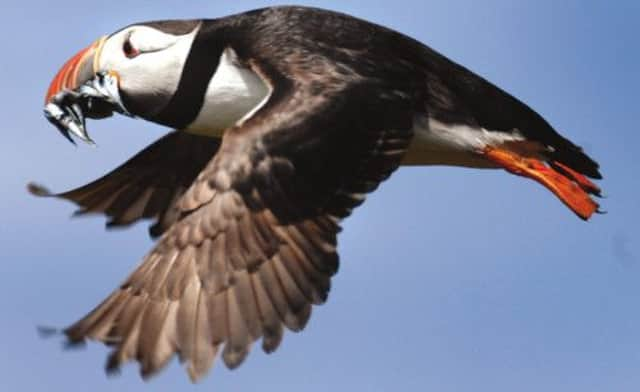Puffin protection hopes for native red fescue grass


But now scientists believe they may have found a far easier and permanent way of stopping tree mallow from blocking the nesting burrows of puffins than endlessly cutting it back.
A breakthrough study has found that a gradual natural return of native red fescue grass on Craigleith Island in the Firth of Forth is significantly breaking down mallow seeds, preventing the growth of new plants.
Advertisement
Hide AdAdvertisement
Hide AdResearchers at the University of Aberdeen now plan to conduct trials to find out whether deliberately sowing more native grass will speed up its return and could eradicate the tree mallow altogether on Craigleith and nearby Fidra.
Conservationists hope that the discovery will help to protect puffin colonies in the Forth, as well as saving millions of pounds around the world currently spent on programmes to combat a host of invasive plant species.
Dr René van der Wal, an ecologist at the Aberdeen University’s Centre for Environmental Sustainability, who led the research, said: “Millions of pounds are poured into invasive plant species control and it’s always from cutting or spraying without looking in any great detail at what is happening.
“The spirit of many programmes dealing with invasives has been to get the [previous native] vegetation back but [what has not been realised is] that in itself starts to break down the seed bank of mallow.
“On Craigleith the problem is that we could continue indefinitely [to cut down the mallow] because there are hundreds of thousands of seeds per square metre which you are battling against.
“We have found that the native grass has started to come back naturally and that is changing the soil composition and breaking down the mallow seeds, which are decomposed by fungi and bacteria. We had not known before that that was so effective.”
Van der Wal said native grasses were reviving naturally but very slowly, over decades. “Half the island is already in a good state because the native grasses have grown back but the other half has been influenced so badly by mallow that there is almost no other vegetation. We want to do trials to see if sowing seeds of red fescue can replicate that effect to see if it is worth planting native grasses [to eradicate mallow altogether].”
Tree mallow is a Mediterranean-Atlantic herb which is thought to have reached the Scottish islands from gardens on the mainland.
Advertisement
Hide AdAdvertisement
Hide AdIt can grow up to three metres tall and forms dense stands which force puffins to abandon areas where it has invaded because they cannot get into their ground burrows.
Between 1999 and 2006 numbers of the seabirds on Craigleith island plummeted from 28,000 pairs to just a few thousand as the plant took over the ground.
In 2007, organisations including Aberden University and the Scottish Seabird Centre at North Berwick used a £250,000 landfill tax funding award to establish a five-year project called SOS Puffin, recruiting hundreds of volunteers to cut down the plant so the birds could return to breed.
Results were swift, with tree mallow cover back down to 28 per cent later that year and 96 per cent of burrows re-occupied by puffins, compared to 30 per cent in areas where tree mallow had been left to grow.
But the prolific nature of the plant, which produces 4,000 viable seeds per square metre of ground, meant that the task was an endless one. Groups of around ten volunteers go out between 15 and 35 times a year to repeat the job, which costs £2,000 to £3,000 annually in equipment and training.
Scottish Natural Heritage, which has funded the Aberdeen University research, said a better solution would make a big difference to the conservation effort.
Michael Thornton, SNH operations officer for East Lothian, said: “It’s important to try to make significant inroads into removing invasive plants because we have internationally important populations of breeding seabirds in the Forth, especially ground nesting birds.”
However, he added: “We still don’t know how long it could take to eradicate tree mallow fully.”
Advertisement
Hide AdAdvertisement
Hide AdScottish Seabird Centre trustee John Hunt, who co-ordinates the SOS Puffin project, gave the study a more cautious welcome. He said: “It would be a bit premature to say it will work. We’re happy to accept that it would be worth a trial but there is a question mark as to whether sowing native grass seed will eradicate mallow.”
SEE ALSO:
Twitter: @ScotsmanJulia